Kudymkar: brewing at the edge of Europe
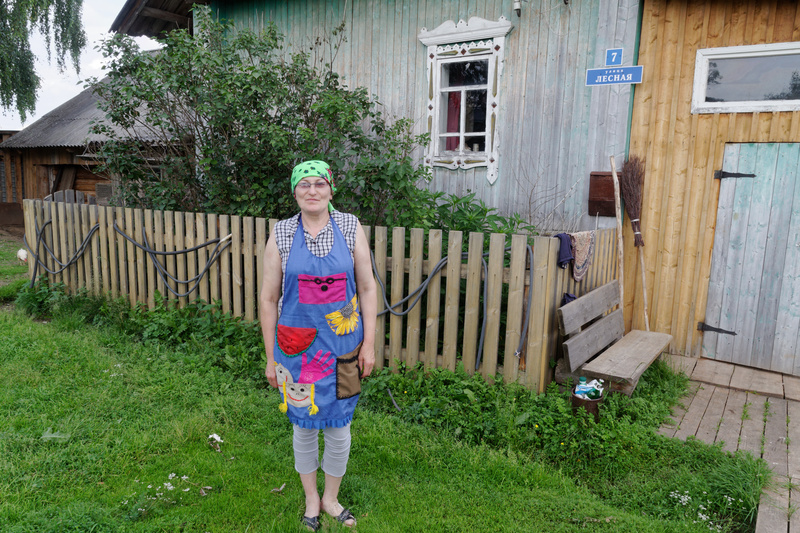
Marina in front of her house |
We drove straight through Kudymkar. Coming out on the north side I asked Ivan where we were going. We were on our way to brew a local farmhouse ale with Marina Ivanovna, a Komi woman, but I didn't really know exactly where. Just that it was somewhere in the Kudymkar area. "The village is Mezhuyevo," Ivan said, "but she said we can't find it with the GPS." In the end Ivan managed to guide us to the village and the right house by calling Marina and getting directions. (This is the first stop on the Russian farmhouse ale expedition.)
Despite her Russian name, Marina belongs to the Komi people, a people distantly related to the Finns, Estonians, Seto, Hungarians, and Sami. They are quite distant physically, too, living in the far east of European Russia. Kudymkar is more or less on the southern edge of the Komi area, about 200 kilometers by road north of Perm. Perm is the local regional centre, a city of roughly 1 million inhabitants. Perm again is about 200 kilometers east of the Ural mountains, the border between Asia and Europe, so this is on the very edge of Europe. Moscow is 1200 kilometers to the west.
The village looked like any other village in Russia, really: a cluster of traditional wooden houses, neatly arranged in rows, with wide, grassy spaces (the streets) in between. The fields were ranged around the cluster of houses. We went down a couple of streets before finally we stopped in front of one of the houses that looked exactly like the others, except Marina was standing in front of it, waiting for us.
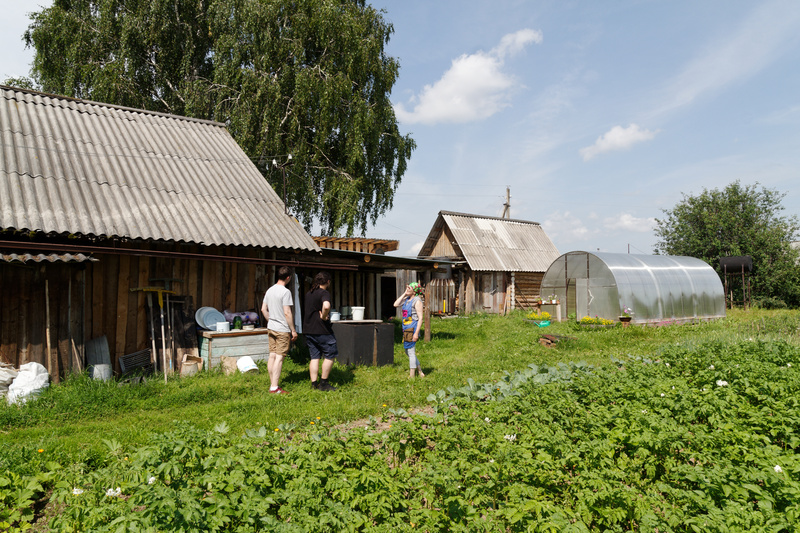
The house seen from the other side |
Facing the street was just the front of the buildings, and fences in between. Going into the house I realized that was not like Scandinavian buildings. There was an inner core that had the living rooms, and then around it were rougher rooms more like a barn or a threshing floor. Marina led us round the inner core, then down into the cellar where the kitchen was, because that's where she does her brewing.
Marina told us that she learned to brew from her mother, simply by being around when her mother brewed. The brewing seems to have more or less died out, because Marina says that 10 years ago very few people were brewing. Now there's been a revival, and she herself started brewing 5-7 years ago.
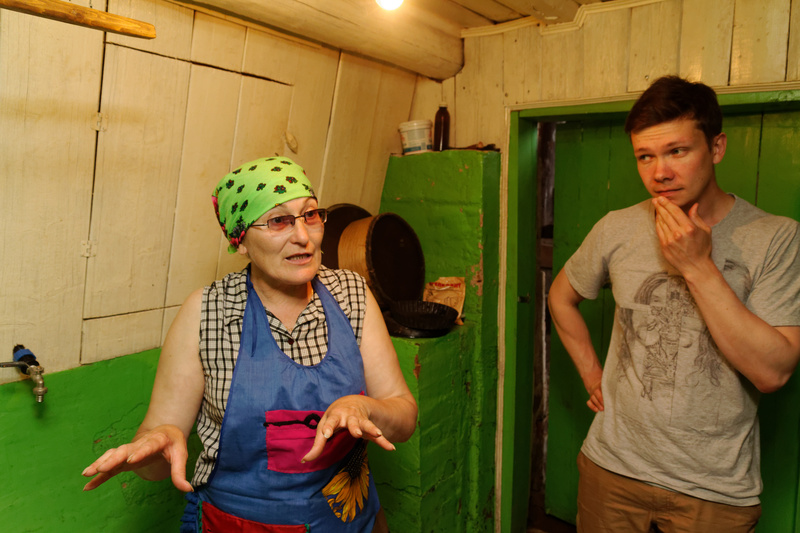
Marina explaining |
She's started organizing a "Sur Festival". Sur is the name of the beer, which is interesting, because "sör" is Hungarian for beer. Have these people been brewing for so long that they retain similar words for beer in language branches so far apart? So it seems, because in parts of Finland beer is called "soro".
This made me curious how similar Komi is to Finnish, a language it must have parted from thousands of years ago, so I asked Marina to say "one-two-three" in Komi. "Ötik, krk, kolim," she said. Not very close to the Finnish "yksi, kaksi, kolme," but clearly related.
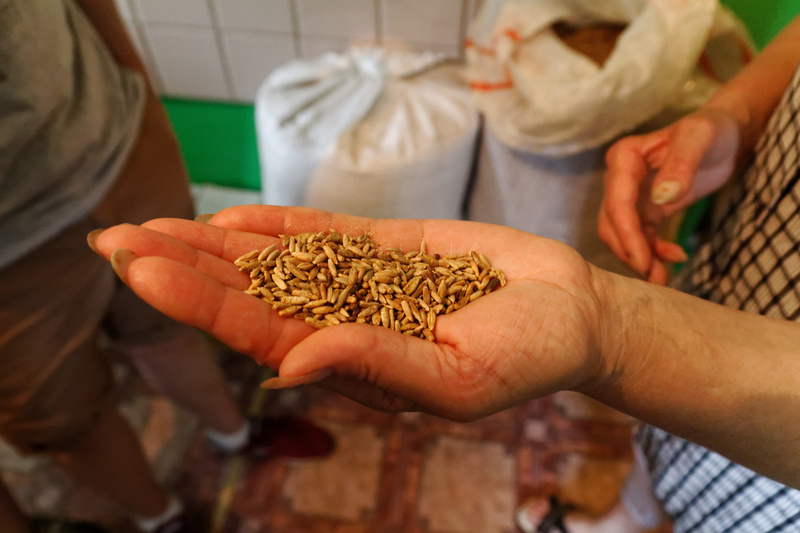
Marina's rye malts |
When Marina brews, the first step is really the malting, because here people make their own malts. The rye is bought from the local collective farm, then soaked in water. The next step is to sprout them for two days in a kind of wooden trough. Finally, the malts are dried in a similar trough on top of the oven. So she makes very pale rye malts.
And, yes, Marina has a huge oven in her kitchen. As far as I can tell, it's a classical Russian oven. Having it in the cellar means it's right underneath the rooms where the family live, which seems like a good idea in an area where temperatures drop to -40C, and sometimes below, in winter.

Marina mashing in |
When brewing, Marina starts by heating water to 98C, then mixes it with crushed malts. The ground malts are pale beige when dry, almost white like wheat flour, but when the water is mixed in it turns dark brown, like chocolate. I guess this is why rye bread is always so dark. At the end of the mixing I measured the temperature to 61C.
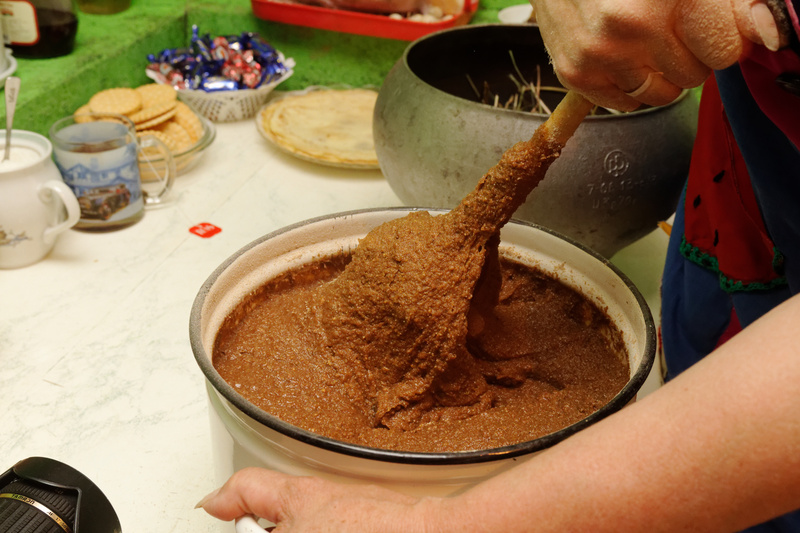
The mash has gone brown |
The next step is to put the mash in the oven, which has been heated gently with firewood beforehand. Since it's not so hot the temperature of the mash rises quite slowly, and so this is where the mashing takes place. What the temperature curve is like is impossible to say. She leaves the mash in there for 24 hours. These ovens stay warm for days, so the mash is still warm when it comes out.
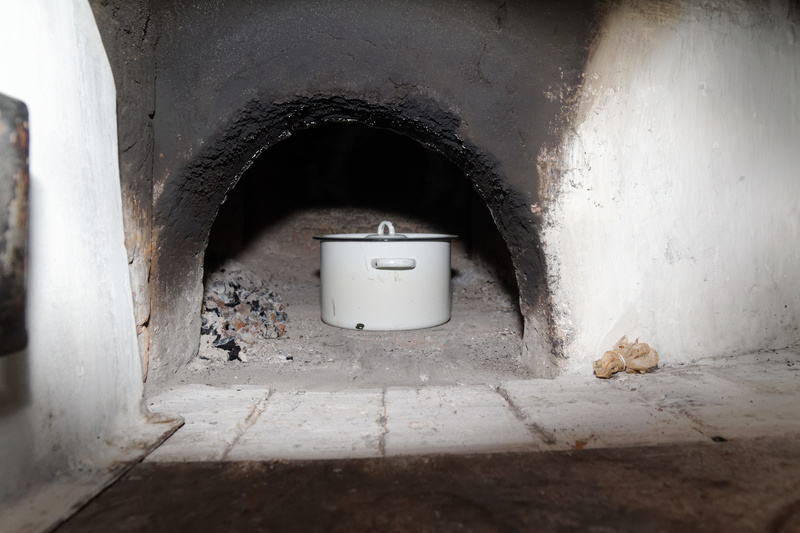
The mash in the oven, ready to come out |
Sometimes she sprinkles a bit of sugar on top of the mash, so that it's caramelized in the oven and adds flavour. She says that if the mash is in the oven longer than 24 hours it gets a bitter flavour. She has to check on the mash after an hour, and adds water if it has gotten too dry.
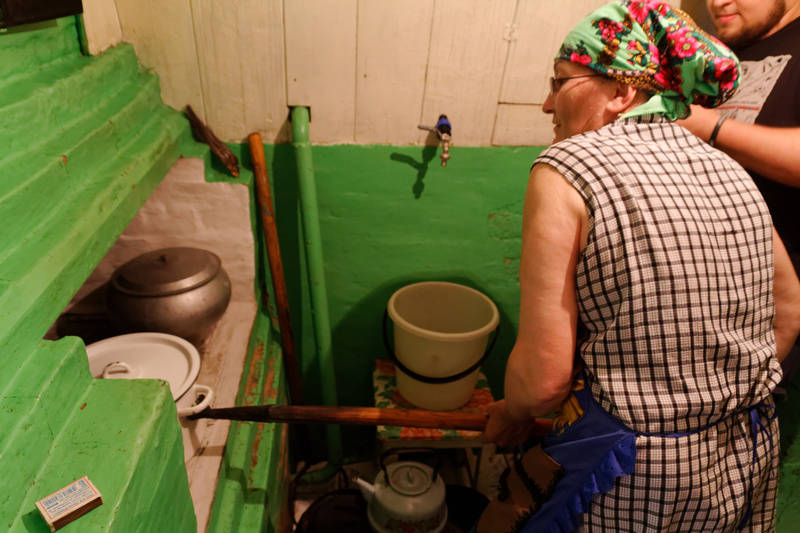
Retrieving the mash |
Marina said that the flavour of the beer is different from batch to batch, and she thinks this is because she doesn't have precise control over the temperature in the oven. She also told us that some people in the area mix water at 50-60C into the malts, which must produce a pretty cold mash. In this case the oven does most of the heating. She said these brewers get a different flavour.

The baked mash |
The oven is the limiting factor in her brewing, so her batches are only 10 liters. She uses 4.5 kilos of home-made rye malts per batch.
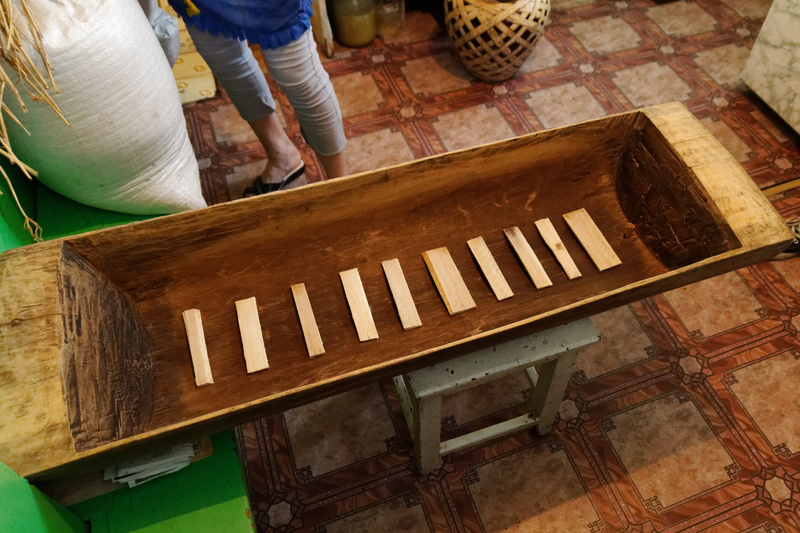
The ör. Hole with plug just barely visible at right-hand end. |
Once the mash comes out of the oven it's time to start lautering. For this she uses a low wooden trough called "ör" in Komi. It's strikingly similar to the kuurna the Finns use for lautering sahti. The main difference is that in the ör the hole for the wort is in the bottom, and not in the side. The ends are also shaped differently. Whether this similarity has anything to do with a common heritage I don't have enough data to say for certain, but I suspect the Russians also used this type of lauter tun.
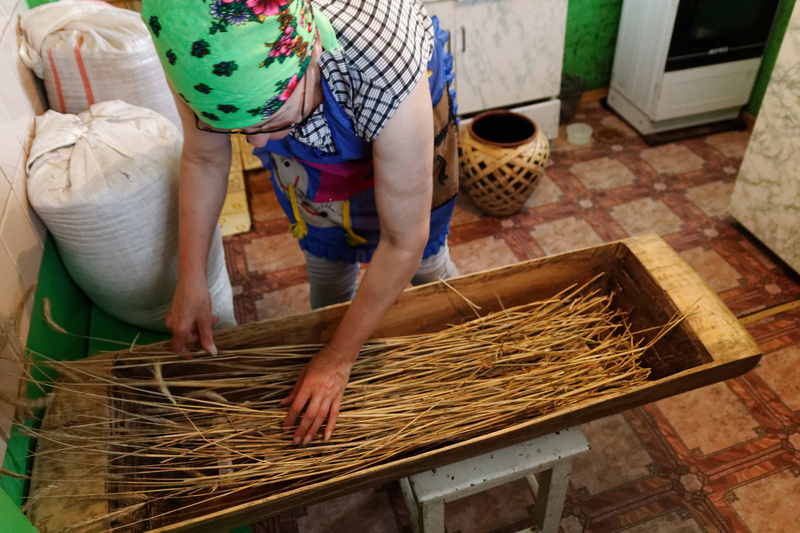
Putting straw on top |
Anyway, Marina lays wooden spiles across the bottom, then straw on top of the spiles. The spiles now create a clear space underneath the straw where the wort can run to the hole. On top of the straw Marina lays a thin cloth to serve as the filter. The malts have been ground very finely, which is probably the reason why this is necessary. Marina says the village has only one mill, so everyone uses that.
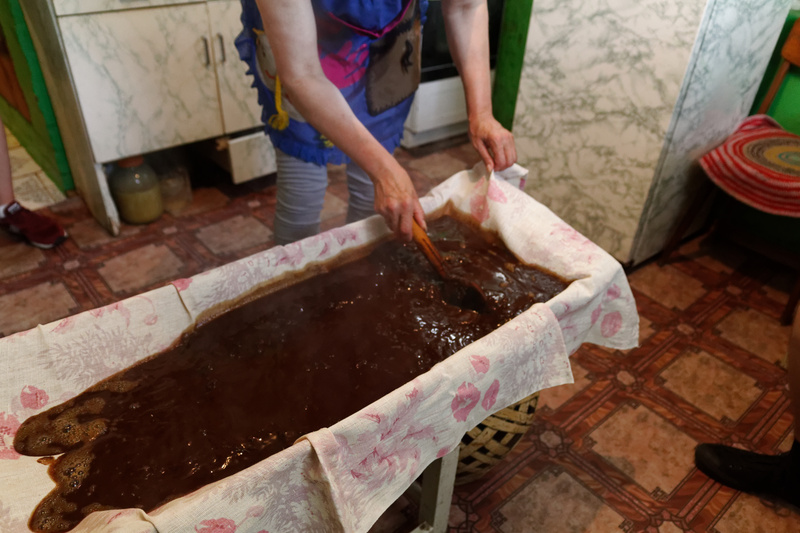
Stirring the mash while lautering |
She pours the mash into the ör, where it looks like some kind of black pudding. Marina says that if the malts are ground finely the mash must be quite dry in the oven. Now she adds hot water to get ready for lautering. Once all the water is in she starts running off.
The first wort is intensely sweet and feels kind of "muddy," probably because the grains have been milled so finely that it's not possible to filter out all the particles. The taste is dark and toasty, almost too much so. The last wort she runs off reminds me of Turkish coffee.

The mash is beginning to go dry |
She produces two worts: one is for the real sur. This is just cooled, and then has yeast pitched. The second one makes the small beer. It is put in a pot with two handfuls of hops, brought to a boil, and then left to draw for 10-15 minutes. She adds sugar to the small beer, and thinks the small beer is actually stronger than the main beer.
Running off turns out to be difficult, because the flow stops several times. In one case her mother has to come down and look, and the two of them discuss what to do. In the end the solution is to scrape some of the malts off from the cloth. This seems to restart the flow.
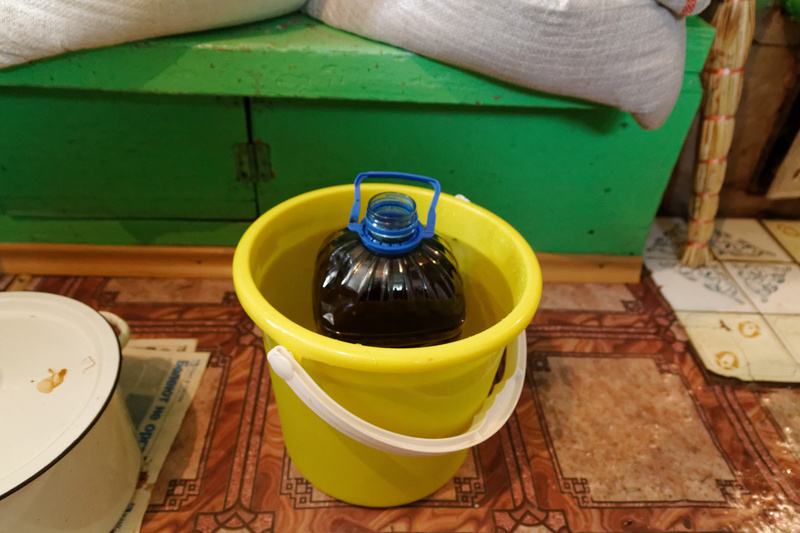
Cooling the wort |
Now the wort is cooled with cold water. In the winter she will take it outside and cool it in the snow. She doesn't know the correct pitch temperature, but says she can recognize it by tasting the wort. So when she says the temperature is right, I measure it. 31C. The yeast she uses is a bread yeast. She takes 6-7 grams and adds it to a little wort, where she also stirs in wheat flour. After 30 minutes there is visible activity, and she pitches the yeast.

The yeast starter |
She says the beer will be drinkable after 5 hours. A few years ago I wouldn't have believed that, but I saw how fast the yeast in the starter got going, so I'm sure she's right. Although it will probably still be fairly sweet then. She says the beer tastes best after 24 hours.
We go out into the garden so the smokers can have a cigarette. While we're out there we admire Marina's potato field, greenhouse, and vegetable beds. It turns out she's running quite a farm, with chickens and goats, too. One of the guys asks her whether she uses any machines for the farming. Wordlessly, Marina shakes her head, then shows us the hoes she uses for turning the earth. She then picks up a scythe and expertly mows down some of the tall grass. This is farming like people did it on marginal farms in western Norway until about the 1950s.
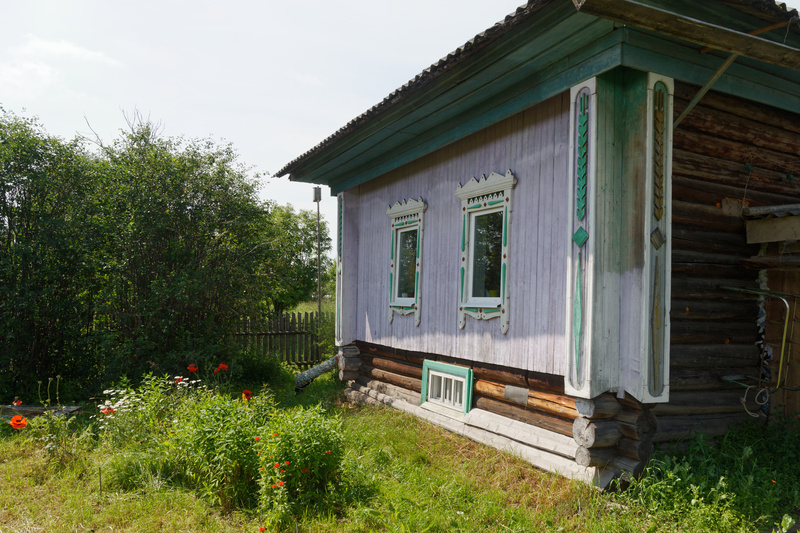
Back side of the house |
Then I notice some rakes leaning against a wall. These are home-made, made from nothing but wood. Even the teeth are little wooden plugs carved so they fit neatly into the holes in the rake. I've seen this type of rake in Scandinavia, too, but only in museums. It looks like Marina basically makes most of what she needs herself, only buying clothes and a few luxuries for money.
Marina tells us that this village is not really remote. She actually was in Perm yesterday, by bus. The villages that really are remote are off the road grid, and in those places you really have to make everything yourself. But she says people are leaving those places and moving to Perm, because life in the city is so much easier. She actually used to live in Perm for 10 years, but moved back because she got sick of city life. She mimes weaving through crowds of people.
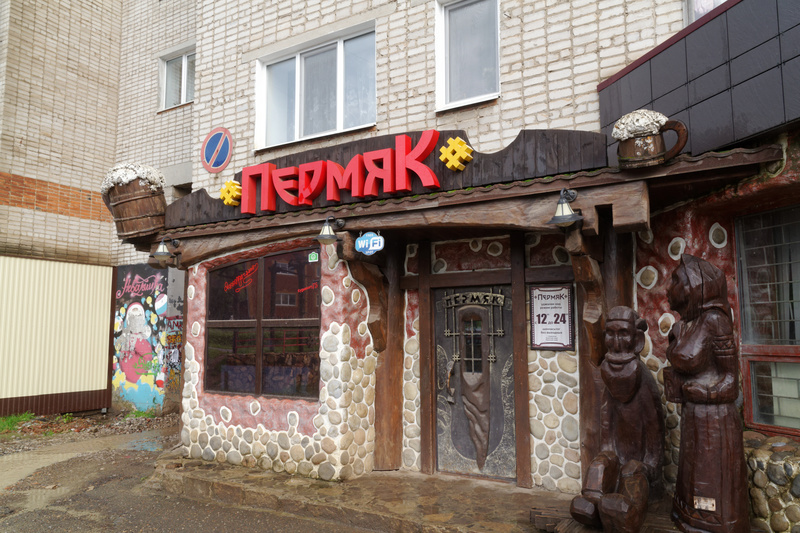
Café Permyak |
And with that it's time for us to leave. We take some group photos in front of the house, then drive off as Marina waves goodbye. But we're not quite finished yet. We drive back into Kudymkar where we find Café Permyak, a rather extravagantly decorated establishment that serves Komi cuisine, and sur.

A glass of sur |
The sur is served in big glass mugs, and looks most of all like capuccino. It's quite fruity, roasty, and earthy, and the fruit character kind of bothers me. It's probably from some type of berry, because Marina said people might add any suitable kind of berry to the beer. The beer also has a lot of malt dust in it, probably because the malts were ground too finely, so to be honest it's a little tough to drink. Later that night, we try Marina's beer, which I like better. It's very similar, but doesn't have the disturbing fruit character.
Recipe
She uses rye from the local kolkhoz (collective farm). The drying seems to be quite gentle, so standard rye malts might be a reasonable substitute. For 10 liters of beer she will use 4.5 kilos of malts. The batch size is so small because of the size of her oven. No hops, no juniper.
The mash pH at the end of the oven baking was 4.9.
I measured her OG to 1.035, but she considered this brew a failure and said the wort should be "twice as sweet." I don't think this was intended as a mathematically precise statement, just as a way to indicate that the wort should be much sweeter. So anywhere from 1.050 to 1.090 might be the intended gravity. If we assume 50% efficiency in the mash, not unusual for home-made malts, then OG would be 1.068. So 1.070 might actually not be a bad assumption.
Add hot water, not too much, to mash at 61C. Then put the mash in a gently heated oven for 24 hours. I assume the oven temperature at the beginning is over 100C, since it's hot enough to caramelize sugar.
Then run off through straw and a thin cloth, cool to 31C, and pitch baking yeast. 24 hours of fermentation, and the beer is ready to drink. I would guess attenuation is pretty standard, probably 70-75%, in which case we're looking at a beer of about 6.5-7%, which would be a fairly typical farmhouse ale.
More details
I don't know that anyone has ever published anything on Komi brewing in English, so here is an appendix with information that didn't make it into the main story.
Some words I managed to note down.
| Komi | Russian | Meaning |
|---|---|---|
| askur | ? | Spirits distilled from sur |
| ör | korito | Lauter tun |
| krinka | krinka | The pot the mash is baked in |
| gvozdyanka | gvozdyanka | Alternate baking pot with lauter hole |
| matei | ? | Stick for stirring the mash |
I saw juniper in the area, but she did not mention it being used. Stupidly, I did not ask explicitly.
The batch size of 10 liters is the traditional one, dictated by the size of the oven. In central Russia a village might get together and buy a big kettle to use instead, but not in this area. People used to brew for religious celebrations and funerals, because the sur was a "sacred drink". Each batch would be intended for a specific celebration, and the whole batch would be drunk there. Everyone brewed for themselves, not for sale. Typically people would brew 5-6 times a year in the old days, but now they have enough grain to brew whenever they want.
In the old days, the everyday drink was kvass.
Marina does not clean the straw before lautering.
Marina's krinka is enamelled metal, but the traditional vessel was ceramic.
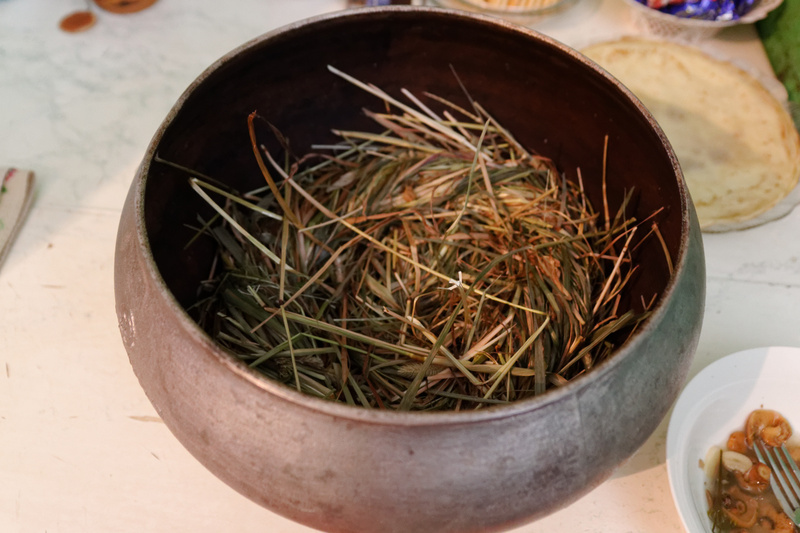
Gvozdyanka with straw filter in bottom |
There is an alternative to the krinka called gvozdyanka, which Marina describes as a new technique. I suspect it's spread to the Komi Republic from other areas where it probably has a longer history. The gvozdyanka has a hole in the bottom that's closed with a wooden peg and malt paste during the baking. At the bottom is the straw filter, and the mash goes on top of that, and you put the whole thing in the oven. It's much easier to use, because you can just take it out and start lautering right away, and the filtering seems to be more efficient. Also, you don't need an ör.
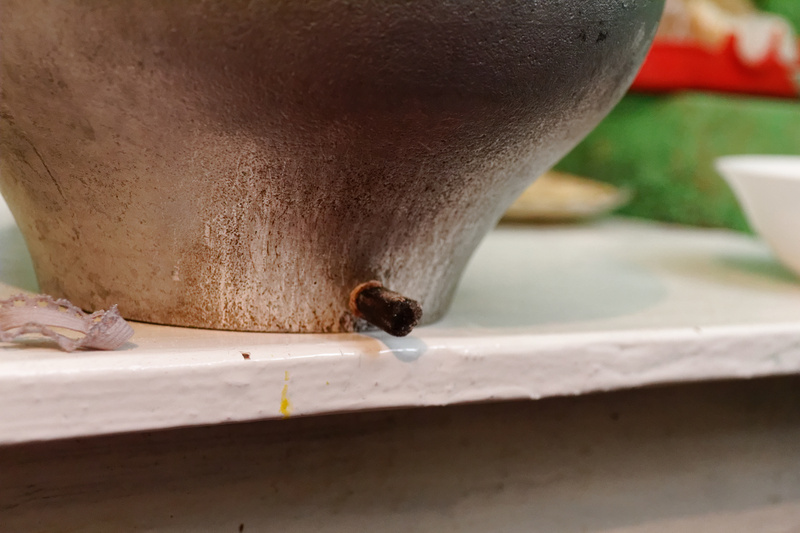
Gvozdyanka tap, about to be sealed with malt paste |
The hops for the small beer are wild hops.
The sur will keep for about a week in the refridgerator. In the old days they would bury it in the ground, and in winter they would add snow on top. We ask if anyone ever forgot it in the ground, and Marina says "oh, no." The beer was clearly much too important for that.
The small beer should ferment 48 hours, and it will improve the longer you mature it in the refridgerator.
The Soviet breweries were required to brew a limited number of standard recipes (I think six), put down by some ministry in Moscow. In Syktyvkar the local brewery got around this by making their own rye malts, and then brewing a sur-like beer with modern equipment and process.
In the old days people would make yeast by mixing flour with water and letting it ferment. They would reuse it, and keep the best. If it went bad they would start over.
Acknowledgements
Many thanks to Marina for her hospitality and for generously showing us the entire brewing process, in two versions, compressed into one day, and answering all our questions.

The guys in Marina's kitchen. Left to right: Elias, Ivan, Sasha |
Thanks to Ivan and Elias of Sabotage Brewery in Perm (when I was there the brewery name was Borodach and Molnin) for setting up the visit, driving us there and back, translation, and hospitality.
Thanks to Sasha for being the main interpreter.
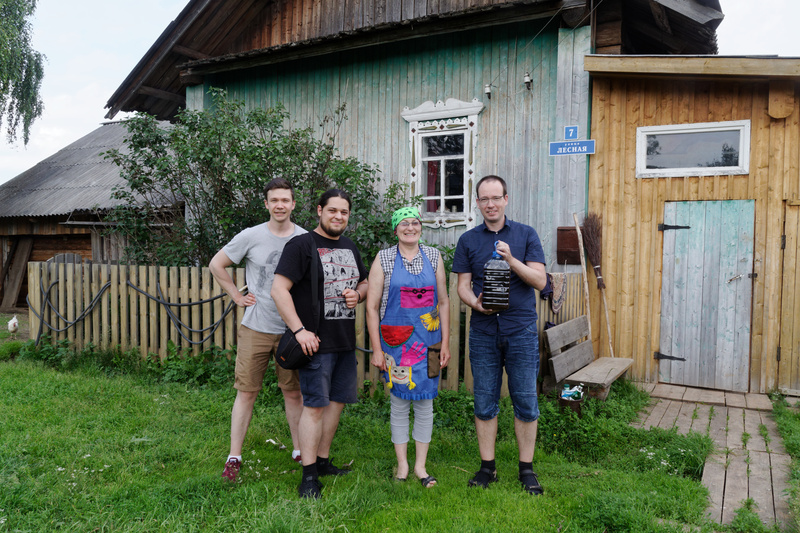
The crew in front of the house, left to right: Elias, Sasha, Marina, me (Ivan took the photo) |
Similar posts
Brewing in Chuvashia
Suddenly, the bus drove out of the forest, onto a bridge spanning an enormous river, deep blue in the sunshine, and so wide it looked more like a lake
Read | 2019-02-03 11:26
Oven beer in central Russia
Dmitriy stopped the car outside his dacha (summer house) in the tiny village of Shitovo, and jumped out
Read | 2018-11-07 19:31
The Russian farmhouse ale expedition
I used to think that Russia was a land of vodka, and that the Russians had no beer tradition
Read | 2018-08-28 19:53
Comments
Olve - 2018-09-17 20:01:44
I love it! Great article, as ever. Never stop exploring and writing, please.
Aaron - 2018-09-18 00:07:12
This is excellent! I really look forward to reading the rest! Should be a national geographic article! Also I need to get me a Russian big stove for my house in Canada.
Oli - 2018-09-19 11:55:17
Great stuff as always!
Lars - 2018-09-27 13:05:36
A great read as always. Looking forward to the next post!
Dennis - 2024-04-10 15:10:54
Lemme leave some "in addition to" here, folks.
Well, the spirits made of sur is to some extent 'bread wine' / 'khlebnoye vino' in Russian. It's still okay to call it 'samogon' but it's now associated with sugarhead, not grain mash.
That straw filter is made of cast iron specially for the traditional ovens. You may call it 'chugunok', 'korchaga', 'gorshok' and so forth. All of them stand for the pot, anyhow.
Thanks for the article. Cheers.